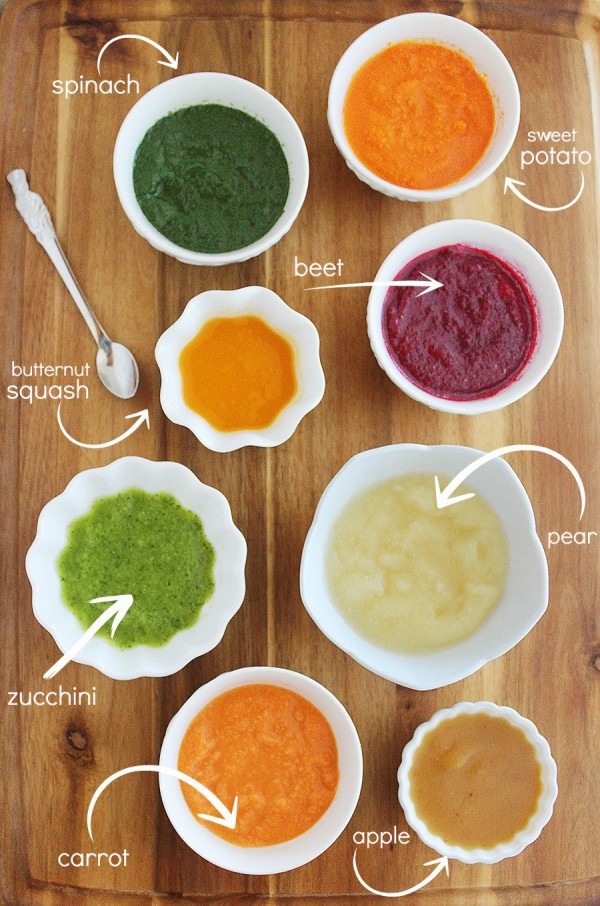As a new parent, the thought of introducing solid foods to your little one can be both exciting and nerve-wracking. You want to make sure your baby is getting all the nutrients they need to grow and develop, but you also want to make sure they enjoy the experience. One way to make the transition to solids a little easier is by introducing baby food purees. Not only are they easy to make, but they also allow you to introduce a variety of flavors and textures to your baby’s palate.
But with so many options out there, it can be overwhelming to come up with ideas for baby food purees. Luckily, there are endless possibilities when it comes to pureeing fruits, vegetables, and even proteins. From classic combinations like sweet potato and apple to more adventurous flavors like avocado and kiwi, the sky is the limit when it comes to creating delicious and nutritious purees for your little one. In this article, we will explore some creative and easy baby food puree ideas to help make mealtime a success for both you and your baby.


Baby Food Puree Ideas: Delicious and Nutritious Options for Your Little One
1. Sweet Potato and Apple Puree
If you’re looking for a sweet and nutrient-packed puree for your little one, then sweet potato and apple puree is a great option. This puree is loaded with vitamins A and C, which are essential for your baby’s growth and development. Plus, the natural sweetness of the apples makes it a tasty and satisfying option for your little one.
To make this puree, simply peel and chop a sweet potato and an apple, and steam them until they’re soft. Then, puree the ingredients together until you reach the desired consistency. You can also add a pinch of cinnamon for added flavor.
2. Avocado and Banana Puree
Avocado and banana puree is another delicious and nutritious option for your little one. Avocado is packed with healthy fats and fiber, which are important for your baby’s brain development and digestion. Bananas, on the other hand, are a great source of potassium, which helps regulate blood pressure and supports healthy heart function.
To make this puree, simply mash half an avocado and half a banana together until you reach the desired consistency. You can also add a splash of breast milk or formula to thin it out if needed.
3. Carrot and Mango Puree
If you’re looking for a puree with a little bit of a tropical twist, then carrot and mango puree is a great option. Carrots are rich in beta-carotene, which is converted to vitamin A in the body and is essential for healthy vision and skin. Mangoes are also a great source of vitamin A, as well as vitamin C and folate.
To make this puree, simply peel and chop a carrot and a mango, and steam them until they’re soft. Then, puree the ingredients together until you reach the desired consistency. You can also add a squeeze of fresh lime juice for added flavor.
4. Broccoli and Pea Puree
Broccoli and pea puree is a great way to introduce your little one to green vegetables. Broccoli is packed with vitamins C and K, as well as fiber and folate. Peas are also a great source of fiber, as well as vitamins A and C.
To make this puree, simply steam a handful of broccoli florets and a handful of peas until they’re soft. Then, puree the ingredients together until you reach the desired consistency. You can also add a pinch of mint for added flavor.
5. Apple and Pear Puree
Apple and pear puree is a classic baby food recipe that never gets old. Apples and pears are both rich in fiber, vitamin C, and antioxidants, which are important for your baby’s immune system.
To make this puree, simply peel and chop an apple and a pear, and steam them until they’re soft. Then, puree the ingredients together until you reach the desired consistency. You can also add a pinch of cinnamon for added flavor.
6. Butternut Squash and Cauliflower Puree
Butternut squash and cauliflower puree is a great way to introduce your little one to new flavors and textures. Butternut squash is rich in vitamins A and C, as well as fiber and potassium. Cauliflower is also a great source of fiber, as well as vitamins C and K.
To make this puree, simply peel and chop a small butternut squash and a handful of cauliflower florets, and steam them until they’re soft. Then, puree the ingredients together until you reach the desired consistency. You can also add a pinch of nutmeg for added flavor.
7. Blueberry and Spinach Puree
Blueberry and spinach puree is a great way to introduce your little one to dark leafy greens. Blueberries are rich in antioxidants, which help protect your baby’s cells from damage. Spinach is also a great source of antioxidants, as well as iron and calcium.
To make this puree, simply steam a handful of spinach leaves and a handful of blueberries until they’re soft. Then, puree the ingredients together until you reach the desired consistency. You can also add a splash of breast milk or formula to thin it out if needed.
8. Pumpkin and Banana Puree
Pumpkin and banana puree is another great option for a sweet and nutritious puree. Pumpkin is rich in beta-carotene, which is converted to vitamin A in the body and is essential for healthy vision and skin. Bananas, as we mentioned earlier, are a great source of potassium.
To make this puree, simply chop a small pumpkin and half a banana, and steam them until they’re soft. Then, puree the ingredients together until you reach the desired consistency. You can also add a pinch of cinnamon for added flavor.
9. Zucchini and Potato Puree
Zucchini and potato puree is a great option for a mild and easy-to-digest puree. Zucchini is rich in vitamin C and fiber, while potatoes are a good source of potassium and vitamin B6.
To make this puree, simply chop a small zucchini and a small potato, and steam them until they’re soft. Then, puree the ingredients together until you reach the desired consistency. You can also add a splash of breast milk or formula to thin it out if needed.
10. Mango and Quinoa Puree
If you’re looking for a puree that’s packed with protein, then mango and quinoa puree is a great option. Mangoes, as we mentioned earlier, are a great source of vitamin A and C. Quinoa is also a great source of protein, as well as fiber and iron.
To make this puree, simply cook a small amount of quinoa according to the package instructions, and then puree it with a chopped mango until you reach the desired consistency. You can also add a pinch of cinnamon for added flavor.
The Benefits of Homemade Baby Food
Making your own baby food has many benefits, including:
- You know exactly what’s going into your baby’s food, and can control the quality and freshness of the ingredients.
- You can introduce your baby to a wider variety of flavors and textures, which can help develop their palate and promote healthy eating habits later in life.
- It can be more cost-effective than buying pre-made baby food.
- It can be a fun and rewarding experience for parents!
Homemade vs Store-Bought Baby Food
While both homemade and store-bought baby food can be nutritious options for your little one, there are some key differences to consider:
| Homemade Baby Food | Store-Bought Baby Food |
|---|---|
| You have full control over the ingredients and can ensure they’re fresh and high-quality. | May contain preservatives, additives, and thickeners. |
| You can tailor the texture and consistency to your baby’s needs and preferences. | May have limited texture and consistency options. |
| Can be more cost-effective in the long run. | Can be more convenient for busy parents. |
Ultimately, the choice between homemade and store-bought baby food is a personal one, and depends on your individual needs and preferences. However, by making your own baby food, you can ensure that your little one is getting the freshest, most nutritious food possible.
In conclusion, making your own baby food can be a fun and rewarding experience for parents, and can provide your little one with a wide variety of delicious and nutritious options. By experimenting with different flavors and textures, you can help develop your baby’s palate and promote healthy eating habits later in life. So why not give it a try? Your little one will thank you for it!
Frequently Asked Questions
Here are some answers to common questions about Baby food puree ideas:
What are some healthy options for baby food puree?
When it comes to making baby food puree, there are many healthy options to choose from. Fruits and vegetables are great options, such as apples, carrots, sweet potatoes, and peas. These provide important vitamins and minerals that your baby needs for healthy growth and development. Additionally, you can add grains like quinoa or brown rice to the puree for added fiber and nutrients.
It’s important to avoid adding salt, sugar, or other seasonings to baby food puree, as these can be harmful to your baby’s health. Instead, opt for natural flavors and seasonings like cinnamon or nutmeg for added taste.
How can I introduce new flavors to my baby’s puree?
Introducing new flavors to your baby’s puree can be a fun and exciting experience. One way to do this is by mixing purees together to create new flavor combinations. For example, you can mix avocado and banana or sweet potato and apple. Another way is by gradually introducing new foods into your baby’s diet. Start with small amounts of the new food and gradually increase the amount over time. This can help your baby get used to the new taste and texture.
It’s also important to be patient when introducing new flavors. It can take several tries for your baby to accept a new taste, so don’t be discouraged if they initially refuse it. Keep offering the new food in small amounts and eventually, they may develop a taste for it.
Can I freeze baby food puree?
Yes, you can freeze baby food puree. This can be a convenient way to prepare meals in advance and save time. To freeze the puree, simply transfer it to an airtight container or ice cube tray and store it in the freezer for up to three months. When you’re ready to use it, simply thaw it in the refrigerator or microwave and warm it up to your desired temperature.
It’s important to note that some foods may not freeze well, such as cucumber or watermelon. Additionally, be sure to label the container with the date and contents to ensure you use it before it expires.
How can I make baby food puree without a blender?
If you don’t have a blender, there are still ways to make baby food puree. One option is to use a food mill or potato masher to mash the food into a puree-like consistency. Another option is to finely chop the food and then mash it with a fork or spoon. This may take more time and effort, but it can be a good option if you don’t have access to a blender.
It’s important to ensure that the puree is smooth and free of any large chunks or pieces to prevent choking hazards.
Can I add meat to baby food puree?
Yes, you can add meat to baby food puree. This can be a great way to introduce your baby to new flavors and important nutrients like iron and protein. When adding meat to puree, it’s important to ensure that it’s cooked thoroughly and free of any bones or gristle. Ground or pureed meat can be added to vegetable puree or mixed with grains like quinoa or brown rice.
It’s important to introduce meat slowly and in small amounts to ensure that your baby’s digestive system can handle it. Additionally, be sure to consult with your pediatrician if you have any concerns about introducing meat into your baby’s diet.


9 Fruit Purees for 4+ / 6+ Month Baby | Stage 1 Homemade Baby Food | Healthy Baby Food Recipes
As a professional writer, I know that introducing healthy and nutritious foods to your baby can be a daunting task. However, making homemade baby food purees is an excellent way to ensure that your little one gets all the essential nutrients they need. The options for baby food purees are endless, and you can customize them to your baby’s taste preferences and dietary needs.
In conclusion, introducing your baby to a variety of tasty and nutritious foods from an early age sets the foundation for a lifetime of healthy eating habits. Making baby food purees at home is easy, affordable, and ensures that your little one gets the best possible start in life. With the endless possibilities of flavor combinations, you can make mealtime exciting, and your baby will love trying new foods. So, get creative in the kitchen and enjoy this exciting journey of introducing your baby to the world of food.




Pingback: 10 Of The Best Homemade Baby Food Recipes